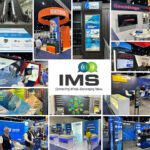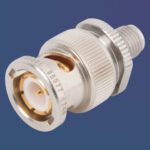PAM4 to the Rescue
As engineers look for ways to improve the efficiency of the data transfer process, PAM4 has emerged as a powerful solution. The ability to double the bit rate without doubling the required frequency allows the use of legacy cables, connectors, and backplanes.

We are living in a digital world, but from a computer’s perspective, there are only two relevant numbers: zero and one. Despite the incredible power of modern computers, they refuse to understand anything other than their own binary language. In order to function, all input must be converted into a series of zeros and ones that represent information. In electronic equipment, a zero is typically represented as a low or zero voltage, while a one is defined as a higher voltage. Logic switches convert data into a series of electronic or optical square waves which are injected into copper or fiber media for computation or transmission.

The shape of these electrical or optical pulses have defined characteristics, including period, rise/fall time, width, and amplitude, which determine the transmission rate and quality of the transferred data.
Modulation is the process of encoding data by changing the state of an electric or optical signal.
Digital information has traditionally been transmitted using a binary modulation system known as Non-Return-to-Zero (NRZ), where a positive voltage represents a one and a negative voltage represents zero.

This two-level system results in one bit of information transmitted or received per transition or clock period and is referred to as pulse amplitude modulation 2 (PAM2). Circuits at the receiver end decode the incoming signals and recreate the data.
As a signal propagates over either medium, it is degraded by a host of factors, including attenuation, crosstalk, intersymbol interference, reflections, and skew. The ability of a circuit to deliver these pulses at required distances with sufficient fidelity to be reliably detected determines the signal integrity (SI) of the channel.
This system has served the industry well for many years, but as speeds increased, so did the problems attributed to increased bandwidth. To push more data across a transmission line, the rise and fall times must be faster and the width of the pulse shortened. These rapid transitions generate noise and aggravate signal loss and distortion which only gets worse with increasing channel length. This has major implications on conductors and connectors, which were beginning to reach the performance and signal density limitations of traditional design.
System engineers and project managers prefer staying in their comfort zone to avoid risk. To continue using familiar design rules and hardware at higher data rates, PCB materials were upgraded, single ended signaling was replaced with differential signaling, PCB layout was optimized for impedance control, and use of shielded differential pair cable increased. Connector designs, including the PCB launch, were optimized and new generations of signal conditioning software, including forward error correction (FEC), were introduced. As demand for channels operating at 25+ Gb/s increased, it became apparent that NRZ signaling was nearing its practical limit.
Improving the efficiency of the data transfer process by increasing the amount of information transferred per cycle would be a much better solution. The ability to double the bit rate without doubling the required frequency would allow the use of legacy cables, connectors, and backplanes. That solution became the Holy Grail. Engineers would be able to utilize their experience with existing circuit design and hardware to avoid suffering through a costly and time-consuming learning curve. Replacing traditional NRZ signaling with four-level pulse amplitude modulation (PAM4) was exactly the solution the industry needed.
PAM4 modulation features four voltage or optical levels which enable the transmission of two bits per machine cycle, effectively doubling the efficiency of a channel.

Baud rate (also known as symbol rate) specifies the total number of times the overall state of a given signal changes per unit of time. Bit rate indicates the total number of bits transmitted per second. The ability to double bit rates without increasing the machine cycle frequency mitigates the problems associated with higher frequencies.
PAM4 modulation also reduces the time to transmit a word by 50%.

The result is that a channel operating at 25 Ghz could deliver 50 Gb/s of data. This is the best gift the industry could hope for, given the combined pressure of increasing data rates, adversity to risk, and reduced cost. PAM4 now dominates channels designed for 56 Gb/s and above. The prospect of 400 Gb Ethernet made PAM4 signaling an imperative while opening the potential for 112 and 224 Gb/s channels.
Comparing NRZ with PAM4 modulation highlights the advantages and differences of the two modulation schemes.

As with many gifts, some serious strings are attached to the use of PAM4. Since each cycle is now broken into four levels, the resulting eye diagram is much smaller. Designers want the openings of eye diagrams to be as large as possible to assure reliable transmission. The PAM4 vertical eye opening is only one third of NRZ, making PAM4 signal to noise ratio (SNR) significantly more susceptible to noise.

Test and verification are also more challenging. Successful utilization of PAM4 signaling often requires the use of advanced compensation, including forward error correction. Increased power consumption related to compensating for these negative factors may also increase. The bit error rate (BER) of the system will suffer if these issues are not addressed.
Despite these challenging issues, PAM4 signaling has become the preferred mechanism to achieve 56+ Gb data rates in both copper and fiber optic channels. Standards organizations are getting on the bandwagon, including OIF, PCIe, and Ethernet. The 400 GbE task force (802.3bs) adopted PAM4 based on 8 x 53.125 Gb/s signaling. The newest PCIe 6.0 specification adopted PAM4 signaling for the first time in its history. Intel sees PAM4 signaling as a key technology to enable next-generation computers to efficiently support the transfer of zettabytes of expected annual data center traffic.
As the industry continues to push transmission data rates to 800G Ethernet and above, design engineers are exploring the advantages and challenges of PAM6 and PAM8 modulation as possible solutions to the data transfer demands of the future.
Learn more about technology development with Bob Hult’s Technology Trends series.
Like this article? Check out our other PAM4 and Technology Trends articles, our Sensors and Antennas Market Page, and our 2023 and 2022 Article Archive.
Subscribe to our weekly e-newsletters, follow us on LinkedIn, Twitter, and Facebook, and check out our eBook archives for more applicable, expert-informed connectivity content.
- Optics Outpace Copper at OFC 2024 - April 16, 2024
- Digital Lighting Enhances your Theatrical Experience - March 5, 2024
- DesignCon 2024 in Review - February 13, 2024





